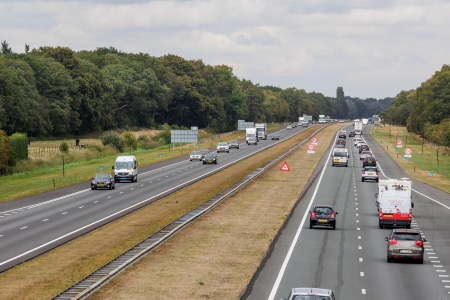The most important measures can be taken in the prescribed clear zone; see the question What does a safe roadside (or outer verge) look like? With obstacle removal or forgiving obstacle shielding in the prescribed clear zone, up to half of the casualties in run-off-road crashes can be prevented [8].
Also important are enhancing the load-bearing capacity of roadside and providing a semi-hardened shoulder next to the carriageway. This provides drivers with more control over their vehicles, allowing them to slow down their vehicles in a controlled manner and steer it back out of the roadside if necessary. Although effect estimates of these specific measures are lacking, US research shows that surfaced roadsides of 60 or 180 centimetres reduce crashes by up to 13% and 33%, respectively [32].
A third type of measure is a flexible shielding structure. This can be an alternative to removing obstacles, such as trees, from the prescribed clear zone. However, there must be sufficient space between the obstacles and the lane: it must be possible to position the shielding structure outside the recovery zone next to the road and at a sufficient distance from the obstacles (see the question What does a safe roadside (or outer verge) look like?). With a shielding structure, as with an clear zone, it is expected that up to half of the casualties in run-off-road crashes can be prevented [8].
According to Van Petegem et al [8] roadside safety can be further optimised by combining an clear zone with a shielding structure at a somewhat greater distance from the road, at the end of the clear zone.
On roads where neither the required clear zone nor a shielding structure is possible, lowering the speed limit is sometimes considered, for example from 80 to 60 km/h. This is because the required clear zone is smaller the slower the speed (see the question What does a safe roadside (or outer verge) look like?). However, lowering the speed limit will only lead to an improvement in road safety if the speeds driven actually drop to or below the new limit, and the measure does not lead to shortcuts via access roads. After all, access roads are not designed to handle larger traffic volumes, and on these roads vulnerable road users and motor vehicles mix.
Finally, inspection and maintenance are important for keeping roadsides safe, as is also shown by recent European research [33]. This is because a safely constructed roadside can become unsafe due to, for example, self-seeding of trees, subsidence of the roadside and corrosion of objects, making them no longer 'crashworthy'. In addition, if not adequately maintained, shielding structures may no longer function safely due to, for example, corrosion, subsidence of the roadside or previous crashes. After maintenance, it is important to check whether shielding structures in particular still meet the requirements.
